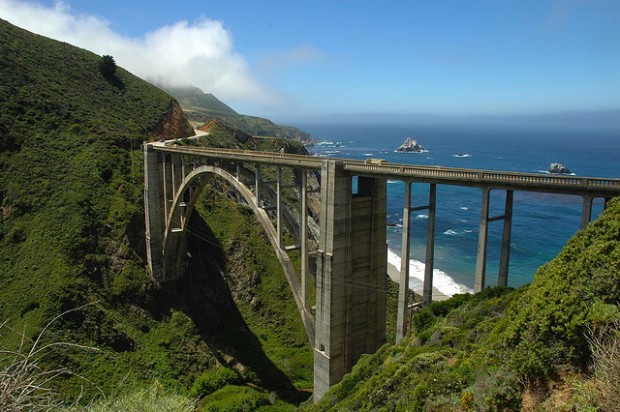Staring at Bridges
 Monday, August 31, 2015 at 4:05AM
Monday, August 31, 2015 at 4:05AM George Washington BridgeI sat in a chair by this window for hours last week, looking out at the George Washington Bridge. I was staying with friends who live in New York, in Washington Heights, and I took this early morning picture through their living room window.
It was hard to tear my eyes away from the span. It was so big and so close. And so loud. 106 million cars and trucks go across this bridge every year, making it the busiest motor vehicle bridge in the world. Even though the sound was muffled through good windows, I felt I could hear every vehicle. And feel every one. Especially the trucks - they shook and rumbled right through the walls.
It wasn’t annoying or scary or depressing. (Well, a little depressing, to think of the energy consumed and the hours wasted sitting stuck in traffic.) No, it was compelling, hypnotic, almost inspiring, this giant steel spanning support, so close.
Think of all the bridges you’ve stopped and stared at. The day before I stared in equal fascination as we drove across the Brooklyn Bridge, a much older NYC bridge (George Washington Bridge completed 1931, Brooklyn Bridge 1883, almost 50 years earlier.) Both bridges are historic and iconic, vital links between the island Manhattan and its neighbors, Brooklyn to the east, New Jersey to the west.
What is it about bridges that is so fascinating? I can think of three reasons – there are probably more. First, there is a compelling danger associated with bridges. Second, even the most simple span is not just functional but also beautiful. And last, bridges compel because they connect, they link two different places. With a beautiful dangerous leap, two become one.
 Brooklyn BridgeBridges are dangerous to build and dangerous to cross. Their builders die digging the foundations, laying the cable, climbing the towers. Construction of the Brooklyn Bridge was overseen by a heroic father and son team, the Roeblings, who both suffered mightily during construction; the father died from injuries, and the son knowingly risked his life diving deep into the East River mud to lay the foundation. Paralyzed with the bends, he oversaw its completion seated in the window of a neighboring building, immobile but in charge (and greatly aided by his wife, who learned much of the engineering and business and might have been a bit wiser about the dangers.)
Brooklyn BridgeBridges are dangerous to build and dangerous to cross. Their builders die digging the foundations, laying the cable, climbing the towers. Construction of the Brooklyn Bridge was overseen by a heroic father and son team, the Roeblings, who both suffered mightily during construction; the father died from injuries, and the son knowingly risked his life diving deep into the East River mud to lay the foundation. Paralyzed with the bends, he oversaw its completion seated in the window of a neighboring building, immobile but in charge (and greatly aided by his wife, who learned much of the engineering and business and might have been a bit wiser about the dangers.)
But danger doesn’t end with completion of a bridge. People jump off bridges, drive off them on purpose or in an accident, ships hit bridges, storms tear them apart, earthquakes crack them in two. All life is dangerous, but there is something about the high span, the rushing river, the soaring towers, the cargo, the fog and wind – all combine to amplify the danger. (Some of my hypnosis staring at that bridge was anticipation that someone might come crashing off it.)
I’ve written before of Vitruvius’ idea that every structure needs three things: strength, usefulness and beauty. A bridge must be strong to stay standing, and it must be engineered to do its job – span the space. But is it also required to beautiful? I can’t think of an ugly bridge. I believe that it is simply in the nature of spanning and connecting that beauty appears; beauty is inherent. Maybe it is the arch that gives it beauty? Flat bridges are a little less interesting. But almost any bridge evokes poetry and emotion, in a way that say, a highway does not. I think that’s because of a bridge’s beauty.
Architect Le Corbusier saw beauty in the George Washington Bridge (even though he disliked the city):
“The George Washington Bridge over the Hudson is the most beautiful bridge in the world. Made of cables and steel beams, it gleams in the sky like a reversed arch. It is blessed. It is the only seat of grace in the disordered city. It is painted an aluminum color and, between water and sky, you see nothing but the bent cord supported by two steel towers. When your car moves up the ramp the two towers rise so high that it brings you happiness; their structure is so pure, so resolute, so regular that here, finally, steel architecture seems to laugh. The car reaches an unexpectedly wide apron; the second tower is very far away; innumerable vertical cables, gleaming against the sky, are suspended from the magisterial curve which swings down and then up. The rose-colored towers of New York appear, a vision whose harshness is mitigated by distance.”
And finally, bridges are compelling because they are connectors, they link and span two often very different places, shores that had long been isolated or linked only by slow ferries. The headlines screamed in 1883; you can now drive or walk directly and fast from Brooklyn right over to Manhattan! What an amazing link. The city has changed. What was once apart is now connected.
Sadly we’ve all also heard some not so joyous stories about bridge links, about remote islands forever changed when it became so easy to get there on the new bridge, supposedly an improvement. Bridges connect. And connection means change. Usually more connection is better than less, but not always.
 Bixby BridgePerhaps some of the thrill of going over a bridge, or seeing one in the distance, is that we are reminded of our own longing for connection. I see orange girders spanning the Golden Gate, or in my neighborhood, the rainbow Bixby Bridge leaping a canyon and I think, “Look, what was separate is now connected. That’s what I want too.” No one is an island, or will last long acting like one.
Bixby BridgePerhaps some of the thrill of going over a bridge, or seeing one in the distance, is that we are reminded of our own longing for connection. I see orange girders spanning the Golden Gate, or in my neighborhood, the rainbow Bixby Bridge leaping a canyon and I think, “Look, what was separate is now connected. That’s what I want too.” No one is an island, or will last long acting like one.
A bridge is about possibility, new connections. It is a safe arch over troubled waters. And it is, in Le Corbusier’s words, a pure, resolute structure of beauty, bringing us happiness, and making us want to laugh.
Copyright © 2915 Deborah Streeter












